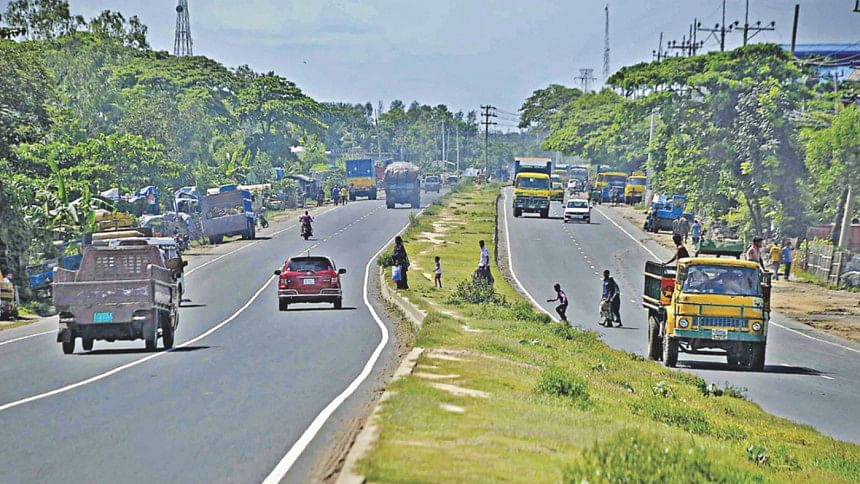Dhaka-Chattogram Highway: Why no feasibility study?

Unfortunately, in our country, feasibility studies are seldom conducted and we end up in a royal mess. The recently completed Dhaka-Chattogram highway that was expanded from two-lanes to four-lanes at a cost of Tk 3,439 crore and inaugurated in 2017, was supposed to have a lifeline of 10 years without any major need for repair. However, two years down the line, the highway is already in trouble and the government has been forced to foot a repair bill costing Tk 793 crore under the head "repair and maintenance". That bill that has just been coughed up from the national exchequer is 23 percent of the original cost of the project!
In the absence of the feasibility study, the project did not fare well in construction—it was completed six years after the original project deadline, by which time the traffic volume on this vital link had also increased significantly. From what has been printed in this paper on September 30, we find a series of things not done and which resulted in things falling apart six months after inauguration. The fact that authorities caved in to transport companies and made the rule to increase the maximum weight limit of goods-carrying vehicles only precipitated the highway's descent into disrepair and the spiralling repair bill that would come barely 18 months down the line.
With poor forecast about increased traffic and overloading, the agreement between authorities and transport companies resulted in flouting global standards by anywhere up to 50 percent more load per vehicle. Then of course, there is the question of authorities imposing fines on overloading and backtracking on that decision within 24 hours when transport owners and workers ran amok damaging weighing bridges in Manikganj and Chattogram districts.
As stated before, the government caved in to unrealistic demands and increased the maximum weight limit of good-laden vehicles from November 2017. What that meant was that two-axle vehicles (six wheels) can carry maximum 22 tonnes, three-axle vehicles (10 wheels) maximum 30 tonnes and four-axle (14 wheels) maximum 44 tonnes. This is in contravention of the global standard of 15.5 and 22 tonnes, respectively, for the above-mentioned vehicles. The original design back in 2006 forecasted that there would be a six percent year-to-year growth in traffic. In reality, traffic had grown at an average of 10 percent per annum.
Then there is the question of quality of workmanship. The physical work on the project was not streamlined and was not done in one go. The Roads and Highways Department (RHD) reportedly was years behind schedule (implementation was supposed to start in 2006 and be completed in 2012) with work starting in 2010 for the stretch from Cumilla's Daudkandi to Chattogram City Gate, and which saw a three-time revision in design. These revisions pushed up the cost from the original estimate of Tk 2,168 crore to Tk 3,439 crore (an escalation of 58 percent). The beauty of this project amidst all the faults of not having done the proper pre-project works like studies and correct forecasting, is that we have a situation where some sections of the highway had been opened up to deal with traffic pressure before actual inauguration in 2017. So, it is safe to conclude that degradation of certain portions of the highway (those that were "unofficially" inaugurated as far back as 2013) suffered from wear-and-tear.
Fast forward to the present, we have conflicting responses from different government agencies and explanations as to why RHD flouted rules about the weight limit for lorries and other transports. A secretary of the RHD told this paper that the decision to increase the maximum weight limit was given due to a "special situation" that allowed for vehicles to use the highway carrying goods up to 40 tonnes and that this limit has now been brought down to 22 tonnes. The unfortunate truth, of course, is that the project has been mismanaged from inception. Agencies involved from the planning to constructing have to share the blame for a poorly managed project that had failed at various stages of project management. At the end of the day, this money is not grant money; it is the taxpayer's hard-earned money that is being thrown away because we refuse to get our act together in handling mega-sized projects.
By the time a major project such as the Dhaka-Chattogram highway extension is fixed, we have thrown away much of the gains that would have been ours to reap had we done our job right at inception. Years of delay defeat the whole purpose of the project, and with time extensions come cost escalations. That, unfortunately, is totally unacceptable given the fact that we have dozens of mega-sized projects in the pipeline using soft (and hard) loans from countries like India and China and multilateral lending institutions such as the manila-based Asian Development Bank (ADB), the World Bank, Japanese JICA, Asian Infrastructure Investment Bank (AIIB). The failure to complete projects on time coupled with the failure to deliver quality workmanship is not lost upon the lending agencies/countries and we run the risk of finding out that some of them may not be willing to fund future projects in the country as we start losing credibility.
Syed Mansur Hashim is Assistant Editor, The Daily Star.

 For all latest news, follow The Daily Star's Google News channel.
For all latest news, follow The Daily Star's Google News channel. 



Comments